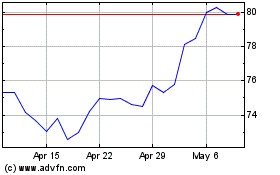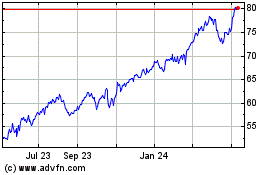AIG Swings to Profit as Disaster Claims Ease -- WSJ
November 02 2019 - 3:02AM
Dow Jones News
By Leslie Scism
This article is being republished as part of our daily
reproduction of WSJ.com articles that also appeared in the U.S.
print edition of The Wall Street Journal (November 2, 2019).
Global insurer American International Group Inc. swung to a
profit in third-quarter net income, as catastrophes took
significantly less of a bite out of earnings than the year
before.
AIG's flagship business of selling property-casualty insurance
to companies world-wide gained more ground in its multiyear
turnaround effort. The unit managed to post a profit, even as Asian
typhoons and some other costly weather events marred results. It
was the third consecutive quarter of improvement for AIG in the
basics of property-casualty insurance: selecting insurance risks
that can be properly priced to make money.
The New York company posted overall net profit of $648 million,
reversing a year-earlier loss of $1.26 billion. In the year-earlier
third quarter, AIG was weighed down by policyholders' claims from
Asian typhoons, California mudslides and Hurricane Florence in the
U.S. Southeast.
Net catastrophe losses declined to $404 million in AIG's
most-recent quarter, or 45 cents a share, compared with $1.3
billion, or $1.45 a share, in the prior-year quarter.
AIG's closely watched adjusted after-tax income, which excludes
items judged nonrecurring, tallied $505 million, or 56 cents a
share. That is an upward swing from a loss of $301 million, or 34
cents a share, in the year-earlier quarter.
Analysts monitor such adjusted results as a measure of the
health of continuing operations. The adjusted earnings were short
of analysts' expectations of about $1 a share. Some of the gap
reflects catastrophe claims unanticipated by analysts from the
Asian typhoons.
AIG also conducts an annual "actuarial assumption" update in the
third quarter. The current quarter included a $143 million charge
for this annual review, compared with a $98 million charge for the
annual update in the prior-year quarter.
The charge reflects a decline in U.S. interest rates this year,
among other factors. Life-insurance products are particularly hard
hit by lower yields on bonds, because insurers derive much of their
profit from investing premiums in high-quality securities until
needed to pay claims.
AIG's management has struggled to deliver above-average
bottom-line results since the 2008 financial crisis, when it nearly
collapsed into bankruptcy-court protection and needed one of the
biggest federal-government bailouts. To fully repay taxpayers, AIG
divested a crown jewel Asian life-insurance unit and many other
businesses to roughly halve itself by assets.
Chief Executive Brian Duperreault, who took over as CEO in May
2017, has hired dozens of new and experienced executives from
across the industry. He also has overhauled insurance packages,
reduced overall expenses, added reinsurance coverage to make
results less volatile, and acquired two insurers.
Write to Leslie Scism at leslie.scism@wsj.com
(END) Dow Jones Newswires
November 02, 2019 02:47 ET (06:47 GMT)
Copyright (c) 2019 Dow Jones & Company, Inc.
American (NYSE:AIG)
Historical Stock Chart
From Mar 2024 to Apr 2024

American (NYSE:AIG)
Historical Stock Chart
From Apr 2023 to Apr 2024
